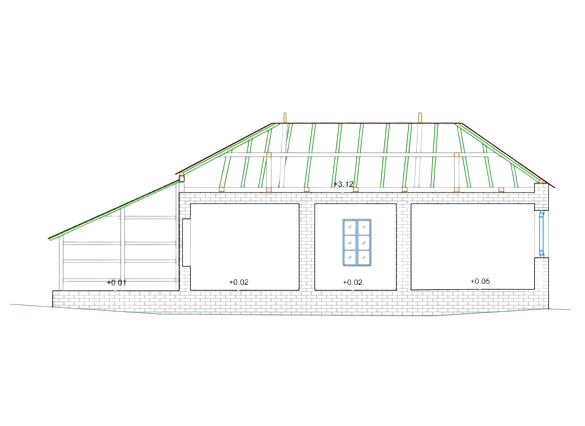Drawings explained:
The elements drawn in 2D

Floor plans:
A 2D plan is a diagram that provides an overhead view of a property or space. It clearly and professionally outlines the walls and room layouts. These plans can be enhanced with additional information such as interior measurements, room sizes, and even specific details about fixtures and furnishings. This comprehensive representation aids in visualizing the overall structure and layout, making it an invaluable tool for planning and design.
Façades:
These plans are crucial for construction supervisors and can significantly impact a project's profitability. They include detailed drawings of a building's façade, highlighting architectural elements and design features. Approval from architects is necessary to ensure these drawings meet design standards and regulatory requirements. This process maintains consistency, quality, and compliance, contributing to the project's successful execution and financial success.


Sections:
Sections offer a vertical cross-sectional view of a building, providing insight into the spatial relationships between floors. Often, multiple sections are created to capture the intricacies of the structure. These 2D drawings are invaluable for visualizing how different levels integrate, detailing aspects such as floor heights, staircases, and vertical connections. Additionally, sections can incorporate axonometric projections, which display the building from various perspectives. This technique enhances the understanding of the design by presenting a three-dimensional view on a two-dimensional plane, ensuring a cohesive and well-coordinated architectural plan.
Roof plans:
The roof plan provides a top-down view of the roof, excluding roofing materials to focus on the Architectural framework. This 2D drawing details the dimensions and arrangement of support elements like beams, trusses, and rafters. It ensures precise specifications for construction, guiding builders and architects in the placement and sizing of each component. Additionally, the roof plan may include slopes, drainage systems, and penetrations for chimneys or skylights, offering a comprehensive overview of the roof's design and functionality.


Roofing plan:
The roofing plan presents a top-down view of the completed roof. It specifies the dimensions, the shape of the roof, and the lines formed by the intersection of inclined planes. Additionally, it details the position and dimensions of skylights, roof windows, chimneys, and ventilation ducts. This plan ensures a comprehensive overview of the roof's final design and layout, highlighting all critical elements and their precise locations.
About the service
Frequently Asked Questions (FAQ)
An Architectural 2D drawing is a scaled technical drawing that includes measurements and details of walls, surfaces, windows, doors, and other Architectural elements. This type of 2D drawing shows dimensions, wall widths, and room layouts, using specific labels for lengths, areas, and angles. Decorative elements, lighting fixtures, and other details can also be added.
2D drawings are crucial for engineers and architects as they provide an accurate representation of the building as constructed. They enhance communication with clients, reducing misunderstandings about element placement and its impact on mobility and open space, ensuring a clear, precise plan for all stakeholders.
A roof plan provides a top-down view of the roof, excluding roofing materials to focus on the Architectural framework. It details the dimensions and arrangement of support elements like beams, trusses, and rafters, as well as information on slopes, drainage systems, and penetrations for chimneys or skylights.
Sections offer a vertical cross-sectional view of a building, showing the spatial relationships between floors. Unlike other 2D drawings that may focus on horizontal layouts, sections detail elements like floor heights, staircases, and vertical connections, often incorporating axonometric projections to present the building from various angles.
The purpose of a 2D plan in architectural design is to provide a clear, detailed representation of the layout and Architectural elements of a building. It serves as a blueprint for construction, ensuring all elements are accurately placed and properly dimensioned. This helps in visualizing the project and aids in planning and coordination among various stakeholders.
Every submission is custom-tailored; there's no universal solution that fits all. Our approach is designed to match the unique needs of each project, ensuring precision in the final digital format. So, yes, we do!
Have questions?
We have the answers!
Reach out to us and we will get back to you shortly.



